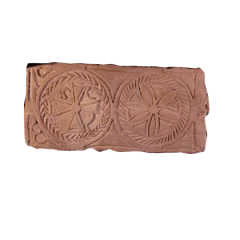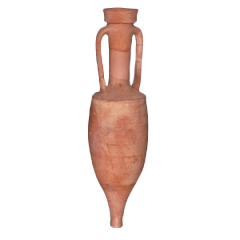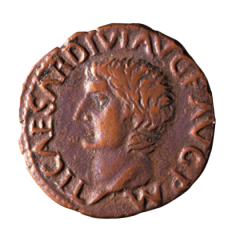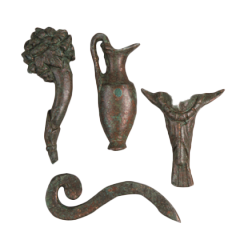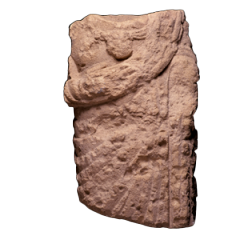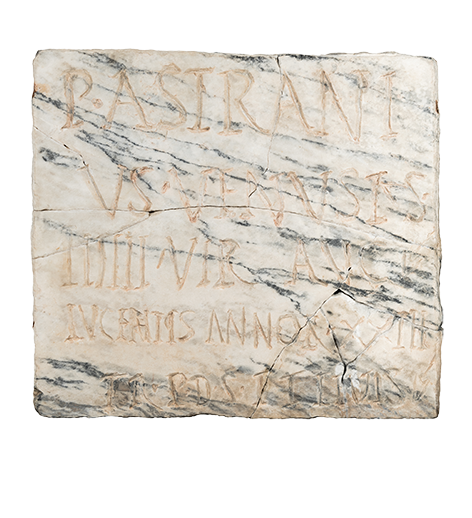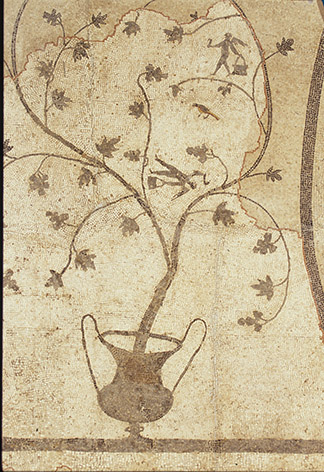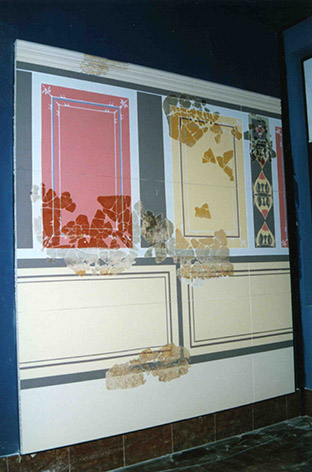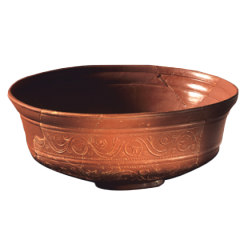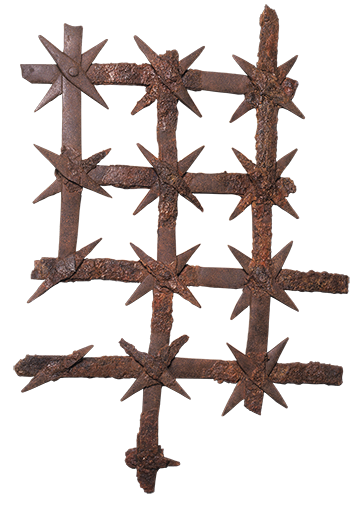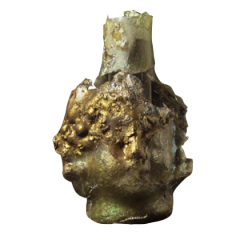
Guttus
Necropolis of El Albir (l'Alfaç del Pi) Glass h: 7'5 cm; w: 4'1 cm; d: 3'6 cm Roman culture 5th century AD: 4'1 cm; e: 3'6 cm Roman culture 5th century AD.
Blown glass ointment in a bivalve mould in the shape of a double human head, joined at the back of the head, which gives the body of the vessel a globular appearance. It depicts two faces of an ephebe, in which the figure of Cupid has been depicted, framed by curly hair. The neck is cylindrical and the mouth is missing, although parallels suggest that it is funnel-shaped. The face on one of the sides is almost complete except for the mouth, but the face on the other is very lost, so that only the outline of it and the hair framing it are preserved.
This type of mould-blown vessel originated in Eastern workshops, mainly Syrian-Palestinian, from where it was distributed throughout the Mediterranean through a fruitful trade. They are also made in the West, and a glass workshop has been found in Rome where they were also produced. There are very few examples of this type of vessel on the Iberian Peninsula; one is in the museum of the necropolis of Carmona, Seville, and another in the Ibizan collection of José Cuesta "Picarol", both dating from the 5th century AD. At the end of this century, this model was replaced in the markets by those with Christian iconography, more in keeping with the tastes of the time.
C.S.: 5811
SÁNCHEZ DE PRADO, Mª D., 2001.
FUENTES DOMÍNGUEZ, A. 2004.
FOY, D. 1995.
Highlights Sala Cultura Romana
- ................................................. Cerro de Las Balsas (Albufereta, Alicante) Sandstone h: 97 cm; w: 46 cm; d: 12 cm h: 66 cm; w: 50 cm; d: 13 cm Roman culture 7th century AD: 46 cm; w: 12 cm h: 66 cm; h: 50 cm; w: 13 cm Roman culture 7th century AD.
- ................................................ Tossal de la Cala (Benidorm) Ceramic h:118 cm; w. 32 cm Roman culture Late 2nd - early 1st century BC: 32 cm Roman culture Late 2nd - early 1st century BC Typology Dressel 1, subtype B.
- ................................................. Isidro Albert Collection Bronze d: 2'12 cm; w: 4'7 g; d.w.:12 h Roman culture 22-23 A.D. 5th issue
- ................................................. Lucentum, Tossal de Manises (Alicante) Bronze Plate: h: 21'5 cm; w: 5'7 cm; d: 0'3 cm Bucranes: h: 7-7'7cm; w: 6'2 cm; d: 1-1'6 cm Urceus: h: 8'7 cm ; w : 3'9 cm; e: 0'8 cm Lituus: h: 10'5 cm; a: 3'5 cm; e: 0'4 cm Cornucopia: h: 9'1cm; a: 4 cm; e: 1'5 cm Roman culture 1st century AD.
- ................................................. Necropolis of El Albir (l'Alfaç del Pi) Glass h: 7'5 cm; w: 4'1 cm; d: 3'6 cm Roman culture 5th century AD: 4'1 cm; e: 3'6 cm Roman culture 5th century AD.
- ................................................. Lucentum, Tossal de Manises (Alicante) Sandstone h: 42 cm; w: 24.5 cm, d: 12 cm Roman culture Second half of the 1st century BC.
- ................................................. Lucentum (Tossal de Manises, Alicante)White marble with grey veinsh: 31.11cm; h: 28.4cm; w: 2cmRoman culture2nd century AD.
- ................................................. Baños de la Reina (Calpe, Alicante) Stone tesserae h: 264 cm; w: 288 cm Roman culture 2nd century AD.
- ................................................. Lucentum, Tossal de Manises (Alicante) Painting applied using the fresco technique on a lime mortar base. h: 305 cm; w: 265 cm h: 303 cm; w: 139 cm; d: 8 cm Roman culture First half of the 2nd century AD.
- ................................................. Lucentum (Tossal de Manises, Alicante) Ceramic h: 23.6 cm; w: 8.1 cm; d: 10.1 cm Roman culture Towards the first half of Nero's reign (50-60/65 BC).
- ................................................. Illeta dels Banyets (Alicante) Iron h: 72 cm; w: 49 cm; d: 3 cm Roman culture 2nd century AD: 49 cm; e: 3 cm Roman culture 2nd century AD.

